

What Happens If We Don’t Recycle? You turn into a green alien forced to live underground for the rest of your life.
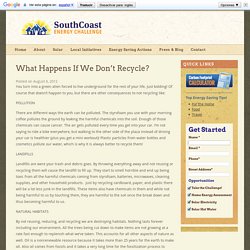
Recycling - How can we help at home? Why Do Animals Become Endangered? Does Recycling Actually Help? Why do we need to recycle? Why Should We Recycle. Several reasons exist as to why we should promote recycling.
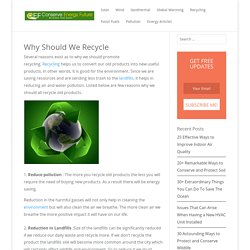
Recycling helps us to convert our old products into new useful products. In other words, it is good for the environment. Since we are saving resources and are sending less trash to the landfills, it helps in reducing air and water pollution. Listed below are few reasons why we should all recycle old products. 1. Reduction in the harmful gasses will not only help in cleaning the environment but will also clean the air we breathe. 2. 3. If more trees are cut down to make such products it will affect wildlife and environment in a significant way. 4. 5.
Rinkesh Rinkesh is passionate about clean and green energy. Why recycle? 5 Reasons Why People Don't Recycle And 5 Reasons They Should. My last post, “I Don’t Recycle” seems to have struck a chord with many.

Leave it to the Care2 community to enlighten, elevate and express their opinions on why people do and do not recycle. Most of us believe that recycling is ethically the right thing to do. From the comments on the post, it was evident that sadly, we all seem to have friends, family and acquaintances that do not recycle. Top 10 Facts About Plastic Pollution In Our Ocean. Project to reduce plastic pollution in our oceans ( I.M. Recycled ) Catalyst ABC TV - Plastic Oceans. Plastic pollution in the ocean. How Recycling Works. Recycling Label Seeks To Clear Consumer Confusion. Recycling — it can get a little confusing at times.

Most people think that if a package has a little recycle symbol (the chasing arrows around a number) on it, that means that item can be recycled. Many people choose packages with that recycling symbol on it thinking they’re making a more sustainable choice. Are you as shocked as I was to find out that little symbol does NOT necessarily mean that item is recyclable? Beth Terry opened my eyes to that fact last year at ShiftCon. The oceans are full of our plastic – here's what we can do about it. By 2050, 95% of seabirds will have plastic in their gut.
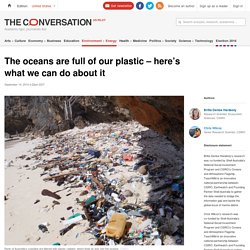
That is just one finding from our national marine debris research project, the largest sample of marine debris data ever collected anywhere in the world. The statistic is just one prediction of what’s in store if we don’t come to grips with the growing problem of rubbish at sea. The issue of marine debris was recently brought to the world’s attention by the search for missing Malaysian Airlines flight MH370, which was reportedly hampered by objects that look similar to aircraft remains. When you consider that six million tonnes of fishing gear is lost in the oceans each year, yet derelict fishing gear doesn’t even crack the top ten most common items found during coastal clean-ups, you begin to grasp the scale of the problem. Plastic not so fantastic The Australian government has a “threat abatement plan” which aims to save marine animals from being harmed by rubbish. Our Plastic Ocean. The world’s oceans are overflowing with plastic.
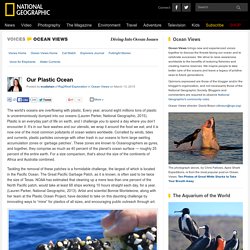
Every year, around eight millions tons of plastic is unceremoniously dumped into our oceans (Lauren Parker, National Geographic, 2015). Plastic is an everyday part of life on earth, and I challenge you to spend a day where you don’t encounter it. It’s in our face washes and our utensils, we wrap it around the food we eat; and it is now one of the most common pollutants of ocean waters worldwide. Corralled by winds, tides and currents, plastic particles converge with other trash in our oceans to form large swirling accumulation zones or ‘garbage patches’. These zones are known to Oceanographers as gyres, and together, they comprise as much as 40 percent of the planet’s ocean surface — roughly 25 percent of the entire earth.
Tackling the removal of these patches is a formidable challenge, the largest of which is located in the Pacific Ocean. U.N. report: Our oceans are trashed with plastic. A series of new reports are raising concerns about the damage plastic waste is doing to oceans -- harming marine animals, destroying sensitive ecosystems, and contaminating the fish we eat.

But experts say that the solution to the problem isn't in the ocean -- it's on land. The United Nations Environment Programme, as well as the NGOs Global Ocean Commission and Plastic Disclosure Project, released reports on Monday ringing the alarm bell about the environmental impact of debris on marine life. Plastic waste in oceans is causing $13 billion of damage each year, according to the UNEP report, and that figure could be much higher. Plastic in Our Oceans by Natalie Westwood on Prezi. Home - Plastic Oceans. Reduce, Reuse, Recycle. Recycling. The three chasing arrows of the international recycling logo Recycling is the process of converting waste materials into new materials and objects.

It is an alternative to "conventional" waste disposal that can save material and help lower greenhouse gas emissions. Recycling can prevent the waste of potentially useful materials and reduce the consumption of fresh raw materials, thereby reducing: energy usage, air pollution (from incineration), and water pollution (from landfilling). Recycling is a key component of modern waste reduction and is the third component of the "Reduce, Reuse, and Recycle" waste hierarchy.[1][2] Thus, recycling aims at environmental sustainability by substituting raw material inputs into and redirecting waste outputs out of the economic system.[3] Ocean Plastics Pollution. Plastic never goes away.
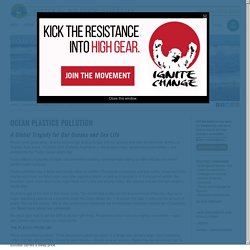
And it's increasingly finding its way into our oceans and onto our beaches. In the Los Angeles area alone, 10 metric tons of plastic fragments — like grocery bags, straws and soda bottles — are carried into the Pacific Ocean every day. There's a Horrifying Amount of Plastic in the Ocean. This Chart Shows Who's to Blame. NOAA Pacific Islands Fisheries Science Center/AP Marine scientists have long known that plastic pollution in the ocean is a huge problem.
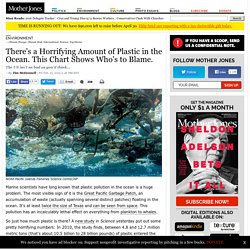
The most visible sign of it is the Great Pacific Garbage Patch, an accumulation of waste (actually spanning several distinct patches) floating in the ocean. It's at least twice the size of Texas and can be seen from space. This pollution has an incalculably lethal effect on everything from plankton to whales. Plastics in Our Oceans. All photos (except where noted) courtesy of Paul Joyce, Sea Education Association by Kimberly Amaral Strolling through the average supermarket, shoppers find literally hundreds (if not thousands) of items to make their lives easier. Individually wrapped snack cakes, plastic baggies to store sandwiches for lunch, unbreakable soda bottles, and disposable razors, diapers, and shampoo bottles. Unless specifically requested, even the bags we use to carry home our goods are often plastic. To humans, these are items of comfort, if not necessity. Photo by K. Plastic--whether it be for a container, a wrapper, or the product itself--has become an everyday part of our lives.
But when plastic reaches our waters, whether it be plastic bags or drifting fish nets, it poses a threat to the animals that depend on the oceans for food. Study: Plastic in 'Great Pacific Garbage Patch' increases 100-fold. Mario Aguilera / Scripps Institution of Oceanography SEAPLEX researchers encounter a large ghost net with tangled rope, net, plastic, and various biological organisms during a 2009 expedition in the Pacific gyre.
Matt Durham (seen wearing a blue shirt) is pictured with Miriam Goldstein. By Ian Johnston, msnbc.com The amount of plastic trash in the "Great Pacific Garbage Patch" has increased 100-fold during the past 40 years, causing "profound" changes to the marine environment, according to a new study. Plastics in the Ocean Affecting Human Health. Author: Gianna Andrews This case study is part of a collection of pages developed by students in the 2012 introductory-level Geology and Human Health course in the Department of Earth Sciences, Montana State University. Learn more about this project. Mountain of Plastic. Photo credit: Top News, "Scientists Baffled by Mystery of Missing Ocean Plastic", Jamie Williamson, Over a few decades, humans have managed to dump tons upon tons of garbage into the ocean.
Recycling Guide. This Is How Your Plastic Bag Ends Up In Massive Ocean Garbage Patches. Local Recycling Centers and Recycling Information and Statistics. Learn How to Recycle and Live Green - RecyclingCenters.org. Video: An ocean of plastic. How You Can Help the Ocean. The threats faced by our ocean planet may seem overwhelming.
In the face of pollution, climate change, overfishing, and other daunting problems, what you can do on your own may seem like a drop in the bucket. But if we begin working together now, we can make a huge difference. Here are some ways to get started: A beach clean-up in Malaysia brings young people together to care for their coastline. 10 Things You Can Do to Save the Ocean. 1. Mind Your Carbon Footprint and Reduce Energy Consumption. Recycling Facts - A Recycling Revolution. Fighting for Trash Free Seas. People know that trash in the water: compromises the health of humans, wildlife and the livelihoods that depend on a healthy ocean;threatens tourism and recreation, and the critical dollars they add to our local economies;complicates shipping and transportation by causing navigation hazards; andgenerates steep bills for retrieval and removal. Oceans of Trash. Kids picking up trash on a beach.